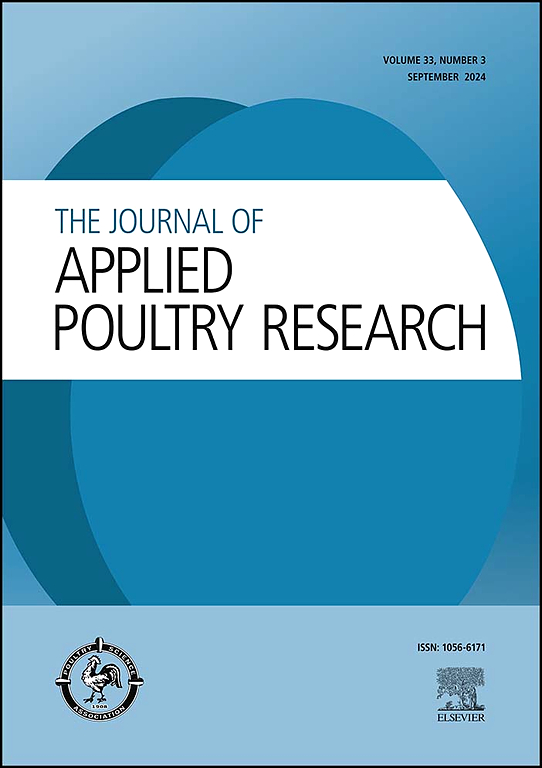Non-phytate phosphorous requirements of pullets from 3 to 6 weeks of age and carryover effects of phosphorous deficiency at 18 weeks of age
IF 2
3区 农林科学
Q2 AGRICULTURE, DAIRY & ANIMAL SCIENCE
引用次数: 0
Abstract
The non-phytate phosphorous (nPP) requirement of 3 to 6 week old laying hen pullets was determined using body weight gain (BWG), mortality corrected feed conversion ratio (FCRm), tibia ash percent (TAP) and tibia ash weight (TAW). Potential carryover effects of early nPP deficiency at 12 and 18 wk were determined with the same parameters. A total of 1,008 Lohman LSL-Lite 3-week-old pullets were distributed across 42 cages and assigned 1 of 7 treatments (0.15, 0.22, 0.29, 0.36, 0.43, 0.49, and 0.56% nPP). There were 24 birds per cage and they were fed ad libitum. Pullets remained in respective treatment groups and phase-fed common diets from 6 to 18 wk. Body weight and FCRm were determined every 3 wk. At 6, 12, and 18 wk of age, 6, 2, and 2 pullets per pen, respectively, were euthanized for tibia ash determination. Data were analyzed using ANOVA in JMP Pro 16.0 and means were separated using Student’s t-test (P ≤ 0.05). Regression analysis from 3 to 6 wk was completed using BWG, FCRm, TAP, and TAW as response variables. The nPP requirement was 0.17% nPP for BWG, 0.14% nPP for FCRm, 0.16% nPP for TAP, and 0.14% nPP for TAW using linear broken line regression. The 0.15% nPP treatment from 3 to 6 wk reduced BW and TAW (P ≤ 0.05) at 6 wk of age. With at least 6 wk of recovery, measured parameters were not different starting at 12 wk (P > 0.05). The nPP requirement for pullets from 3-6 wk of age was 0.16% to maximize bone ash percent with no carryover effects noted by 18 wk of age when adequate nPP was fed from 6 to 18 wks.
3 ~ 6周龄雏鸡对非植酸磷的需求及18周龄缺磷的遗留效应
采用增重(BWG)、死亡率校正饲料系数(FCRm)、胫骨灰分率(TAP)和胫骨灰分重(TAW)测定3 ~ 6周龄蛋鸡对非植酸磷(nPP)的需要量。在12周和18周用相同的参数测定早期nPP缺乏的潜在遗留效应。将1008只3周龄Lohman LSL-Lite小母鸡分布在42个笼子中,并从7个处理(0.15、0.22、0.29、0.36、0.43、0.49和0.56% nPP)中选择1个处理。每笼24只,自由饲喂。在6 ~ 18周期间,雏鸡被分为不同的处理组,并分阶段饲喂普通饲粮。每3周测定体重和FCRm。在6、12和18周龄时,每圈分别对6只、2只和2只小母鸡实施安乐死,以测定胫骨灰分。数据采用JMP Pro 16.0的方差分析,均数采用Student’s t检验(P≤0.05)。以BWG、FCRm、TAP和TAW为响应变量,完成3 ~ 6周的回归分析。采用线性折线回归计算,BWG的nPP需取量为0.17%,FCRm为0.14%,TAP为0.16%,TAW为0.14%。3 ~ 6周0.15% nPP处理降低了6周龄的体重和总重(P≤0.05)。恢复至少6周,从12周开始,测量参数无差异(P >;0.05)。3-6周龄雏鸡的nPP需用量为0.16%,以最大限度地提高骨灰分百分比,在6 - 18周龄时饲喂足够的nPP,到18周龄时没有发现遗留效应。
本文章由计算机程序翻译,如有差异,请以英文原文为准。
求助全文
约1分钟内获得全文
求助全文
来源期刊

Journal of Applied Poultry Research
农林科学-奶制品与动物科学
CiteScore
4.10
自引率
10.50%
发文量
80
审稿时长
104 days
期刊介绍:
The Journal of Applied Poultry Research (JAPR) publishes original research reports, field reports, and reviews on breeding, hatching, health and disease, layer management, meat bird processing and products, meat bird management, microbiology, food safety, nutrition, environment, sanitation, welfare, and economics. As of January 2020, JAPR will become an Open Access journal with no subscription charges, meaning authors who publish here can make their research immediately, permanently, and freely accessible worldwide while retaining copyright to their work. Papers submitted for publication after October 1, 2019 will be published as Open Access papers.
The readers of JAPR are in education, extension, industry, and government, including research, teaching, administration, veterinary medicine, management, production, quality assurance, product development, and technical services. Nutritionists, breeder flock supervisors, production managers, microbiologists, laboratory personnel, food safety and sanitation managers, poultry processing managers, feed manufacturers, and egg producers use JAPR to keep up with current applied poultry research.
 求助内容:
求助内容: 应助结果提醒方式:
应助结果提醒方式:


